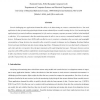Free Online Productivity Tools
i2Speak
i2Symbol
i2OCR
iTex2Img
iWeb2Print
iWeb2Shot
i2Type
iPdf2Split
iPdf2Merge
i2Bopomofo
i2Arabic
i2Style
i2Image
i2PDF
iLatex2Rtf
Sci2ools
HIPC
2005
Springer
2005
Springer
Orthogonal Decision Trees for Resource-Constrained Physiological Data Stream Monitoring Using Mobile Devices
Several challenging new applications demand the ability to do data mining on resource constrained devices. One such application is that of monitoring physiological data streams obtained from wearable sensing devices. Such monitoring has applications for pervasive healthcare management, be it for seniors, emergency response personnel, soldiers in the battlefield or atheletes. A key requirement is that the monitoring system be able to run on resouce constrained handheld or wearable devices. Orthogonal decision trees (ODTs) offer an effective way to construct a redundancy-free, accurate, and meaningful representation of large decision-tree-ensembles often created by popular techniques such as Bagging, Boosting, Random Forests and many distributed and data stream mining algorithms. Orthogonal decision trees are functionally orthogonal to each other and they correspond to the principal components of the underlying function space. This paper discusses various properties of the ODTs and the...
| Added | 27 Jun 2010 |
| Updated | 27 Jun 2010 |
| Type | Conference |
| Year | 2005 |
| Where | HIPC |
| Authors | Haimonti Dutta, Hillol Kargupta, Anupam Joshi |
Comments (0)

